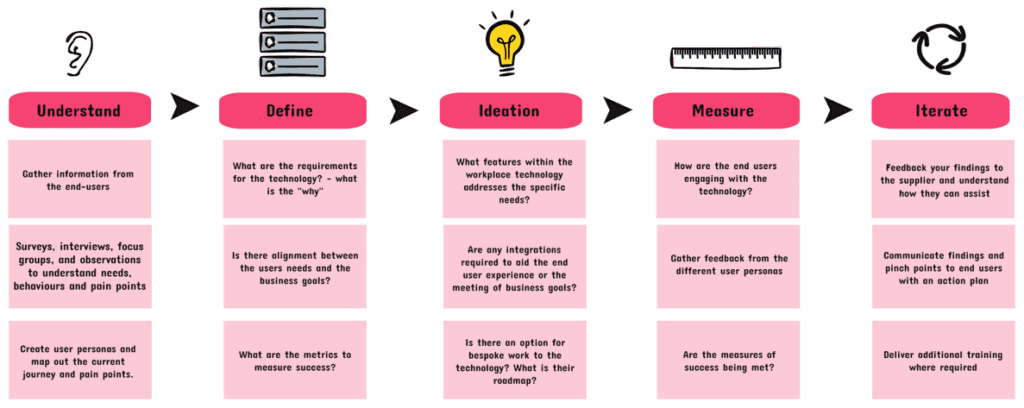Human beings are wired to avoid pain. We try to “fix” the pain, often papering over the cracks.
When it comes to technology within the workplace, I see the papering over the cracks in ways like:
- “What have they pressed now? They must have just pressed the wrong bit”
- “They are just resisting change”
- “Ok, we’ll just do another communication email to everybody”
- “It must be they’re age, I’m a digital native, they’re a digital immigrant”
- “There’s a gremlin in the system, try again later”
- “I’ve tested it and I didn’t have an issue”
- Oh and my favourite… “just turn it off and back on again”
You see, none of these are actually okay statements to make, and yet, for the last 17 years, these types of statements have been a constant. Why?
Because we’re not scoping the end-user needs, desires, or expectations of the technology, we’re not measuring adoption and experience, and we’re certainly not being brave enough to just hold our hands up and say “We chose the wrong system, we need to look to change it”.
Instead, we get hooked into 36-month contracts, fuelled by the sexy features, we deal with a gazillion complaints, suffer from buyers remorse, guilt and anxiety, and when we get to the point of contract renewal, we take a deep breath and we renew, why?
- Because we haven’t got the resource to change
- Because we don’t want to go through all the corporate governance again
- Because we don’t want to do all the end-user change management again
- Because we haven’t got the headspace or energy to just deal with the mess
- Because you want it to work… because it was the system you thought would work!
- Because holding your hands up and admitting it is not working, takes bravery.
The Impact of Avoiding Pain
Avoiding pain by making excuses can lead to a cycle of inefficiency and frustration. For example, blaming user error often results in inadequate training and support, leaving employees feeling unsupported and undervalued. This not only affects productivity but also morale and job satisfaction.
Avoiding pain leads to impacts on: productivity, engagement, team morale, staff churn, and yes, all of this hits the bottom line of the company.
Why the Focus Should be on End-Users
To break this cycle of avoiding pain and fuelling blame, organisations need to prioritise the end-user experience. User-centered design is a methodology that focuses on understanding and meeting the needs of users.
How to act…

By following this process of end user engagement; involving end-users in the scoping, design, implementation and continuous improvement process, organisations can deploy systems that are in line with the end user needs, whilst also meeting business goals.
Consider one company who had a costly legacy system, with poor uptake due to the poor experience, the number of bugs and the features not actually resolving the challenges the individuals or the organisation actually faced – it was something that was just “kind of being used, because it was always kind of used before”.
Consider a second company that implemented end user engagement principles and saw a significant increase in user satisfaction and productivity. By conducting user surveys and usability testing, they were able to identify pain points and make necessary adjustments before full-scale implementation. Into the future they went onto continually review usage and ensure business needs were being met and end users were engaged, they have an excellent relationship with the tech company, developing in partnership; they have a tool they trust.
You could argue the second company had found their Kadence.
Have you found yours?
Reflect:
- Are you dismissing or deflecting tech-related problems and blaming the end-users?
- Are you avoiding pain in your decision making?
- Do you have the resource and expertise within your team to deploy and continually improve your workplace tech tools?
- Do you have success metrics and are they being met?




